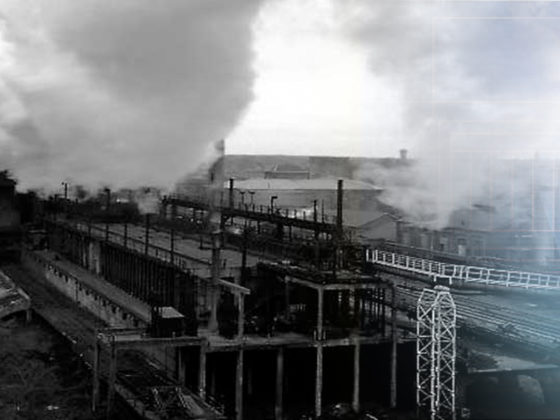

Cokerie d’Anderlues
Site Name: Cokeries d’Anderlues
Address: Rue de la Résistance
Postal Code: 6150
Province: Hainaut
Total Area: 547,900 m²
HISTORICAL
The coal processing, coking, and carbochemistry operations of SA des Cokeries et Houillères d’Anderlues were carried out between 1906 and 2002. Nearby, the coal mine operated from 1850 to 1967. The slag heap, formed by waste from these coal mines, was reutilized between 1983 and 2002 to recover residual coal.
The legacy of the site continues to evolve, with the cokerie anderlues playing a crucial role in promoting sustainable practices and environmental awareness within the community.
In 2006, the site of the former Anderlues coking plant was acquired by a private buyer, Biagio Carà.
From the very beginning, he envisioned a community-driven project: rehabilitating the site and establishing an industrial business park dedicated exclusively to eco-friendly initiatives, the use of recycled materials, and the installation of photovoltaic panels.
From an environmental standpoint, this project offers numerous benefits, as it includes the development of one of the first solar power plants in Wallonia. This would significantly reduce the region’s reliance on external energy sources while providing fully green and renewable power.
GREEN PROJECTS
Belgium’s Energy Transition: From Nuclear Phase-Out to Renewable Solutions
Nuclear Phase-Out: A Pressing Challenge
Today, the Belgian government firmly confirmed the complete phase-out of nuclear power between 2022 and 2025.
But how will the closure of multiple nuclear plants be compensated? Simply by increasing renewable energy capacity—and the need is urgent!
When Gas Becomes Electricity…
The company Gazonor produces green energy by capturing firedamp (methane) from old mining tunnels. It supplies locally sourced energy—in the form of electricity, heat, and eventually gas—to households and industries in Wallonia, harnessing the region’s underground resources.
—
Solar Energy: A Clean, Unlimited Power Source
Unlike fossil fuels, solar energy:
✔ Releases no CO₂ into the atmosphere
✔ Emits zero greenhouse gases
✔ Does not contribute to global warming
It is an inexhaustible, clean, and abundantly available energy source.
The former Anderlues coking plant site, spanning nearly 55 hectares, could soon become a massive photovoltaic park.
Several investors are ready to support this exceptional project and become clean energy producers. Renewable energy is tomorrow’s challenge—a cause I’ve championed since 2009!
—
Hydropower from the Haine River
Harnessing the power of water is one of the oldest, cleanest, and most widely used energy production methods. It is the third-largest energy source worldwide.
A hydropower plant generates electricity without waste or harmful emissions. Run-of-the-river plants utilize the natural flow of a river, providing baseload energy that is instantly fed into the grid.
The idea is to capture the kinetic energy of the Haine River’s current, converting it first into mechanical energy via turbines, then into electricity via alternator.
As a complement to other renewables, hydropower preserves our heritage while revitalizing the local economy.
FOR LOCAL RESIDENTS
Are you a local resident and do you have questions about this project? I am here to listen to you.
CONTACTS

Cokerie d’Anderlues
Site Name: Cokeries d’Anderlues
Address: Rue de la Résistance
Postal Code: 6150
Province: Hainaut
Total Area: 547,900 m²
HISTORICAL
Anderlues Coking Plant: From Industrial Legacy to Green Future
Historical Operations (1906-2002)
The SA des Cokeries et Houillères d’Anderlues conducted coal processing, coking, and carbochemical operations from 1906 to 2002. Adjacent to the site, the Anderlues coal mine was active from 1850 to 1967. Between 1983 and 2002, the mine’s slag heap (terril) was reprocessed to recover residual coal.
A New Vision for the Site (2006 Onward)
In 2006, entrepreneur Biagio Carà acquired the former coking plant with a community-driven vision:
✔ Site rehabilitation
✔ Creation of an eco-industrial park focused on:
– Sustainable practices
– Recycled materials
– Large-scale photovoltaic installations
Environmental & Energy Benefits
The project includes plans for one of Wallonia’s first solar power plants, which would:
✔ Significantly reduce the region’s energy dependence
✔ Provide 100% green, renewable electricity
This transformation turns a former industrial site into a model of sustainable development, aligning with Belgium’s shift toward clean energy solutions.
GREEN PROJECTS
Today, the Belgian government resolutely confirmed the phase-out of nuclear power between 2022 and 2025.
But how can we compensate for the closure of the various nuclear power plants? By simply increasing renewable energy capacity… and this is urgent!!!
When gas becomes electricity…
The Gazonor group produces green energy from firedamp captured in former mining galleries and provides local energy from the Walloon subsoil, in the form of electricity, heat, and ultimately gas, to the region’s populations and industries.
Solar energy
Unlike fossil fuels, solar energy does not release carbon dioxide into the atmosphere, does not emit greenhouse gases, and does not contribute to global warming: it is an inexhaustible, clean energy source available in very large quantities.
The site of the former Anderlues coking plant, with its approximately 50 hectares, could become a huge photovoltaic park in the near future. Several investors are ready to participate in this exceptional project and become clean energy producers: renewable energies are the challenge of tomorrow. I’ve been proclaiming it since 2009!!!
Hydraulic energy from the Haine River
Harnessing the power of water to produce energy: the oldest, cleanest, and most widely used method.
It represents the third largest source of energy production in the world.
A hydroelectric power plant produces electricity without discharging waste or emitting polluting gases.
Run-of-river power plants use the flow of a river or stream to provide baseload energy produced “on the river” and immediately injected into the grid.
The idea is to exploit the movements of the Haine River’s course by recovering kinetic energy, which is first transformed into mechanical energy using turbines and then into electrical energy using alternators. Complementary to other renewable energy sources, hydroelectric energy preserves our heritage and revitalizes the local economy.
FOR LOCAL RESIDENTS
Are you a local resident and do you have questions about this project? I am here to listen to you.
CONTACTS

2021
Follow the progress of the Cokerie Anderlues Plant projects on our social networks.
2021
Follow the progress of the Cokerie Anderlues Plant projects on our social networks.




